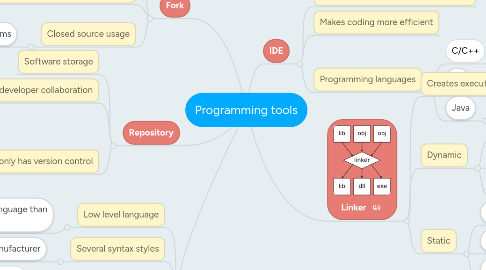
1. Assembler
1.1. Low level language
1.1.1. Closer to machine language than human language
1.2. Several syntax styles
1.2.1. Depending on the processor manufacturer
1.3. 2 types
1.3.1. One pass
1.3.1.1. Goes through the code only once
1.3.1.2. Requires all objects to be initialized at the start
1.3.2. Multipass
1.3.2.1. Goes through the code several times
1.3.2.2. Allows dynamic object creation
2. Repository
2.1. Software storage
2.2. Easier developer collaboration
2.3. Commonly has version control
2.3.1. GitHub
2.3.1.1. Free public repositories
2.3.1.2. Paid private repositories
2.3.2. Bitbucket
2.3.2.1. Free
2.3.2.1.1. 1-5 Users
2.3.2.2. Paid
2.3.2.2.1. 5+ Users
3. Fork
3.1. Copies a programs source code
3.2. Very common in open source communities
3.2.1. Contributions are made by forking a project
3.3. Closed source usage
3.3.1. Multi platform programs
3.3.1.1. e.g. Linux and Windows versions
3.3.1.2. Same on the outside, different on the inside
4. IDE
4.1. Integrated Development Environment
4.2. Makes coding more efficient
4.3. Programming languages
4.3.1. C/C++
4.3.1.1. CodeBlocks
4.3.2. C#
4.3.2.1. Microsoft Visual Studio
4.3.3. Java
4.3.3.1. Eclipse
5. Linker
5.1. Creates executable files
5.1.1. Compiled programming code
5.1.2. Libraries
5.2. Dynamic
5.2.1. Pseudo linker
5.2.2. Allows for linking on the go
5.2.3. Uses same system libraries
5.2.3.1. Prone to breaking due to updates
5.3. Static
5.3.1. Requires more disk space and memory
5.3.2. Portable
5.3.3. Uses its own libraries
